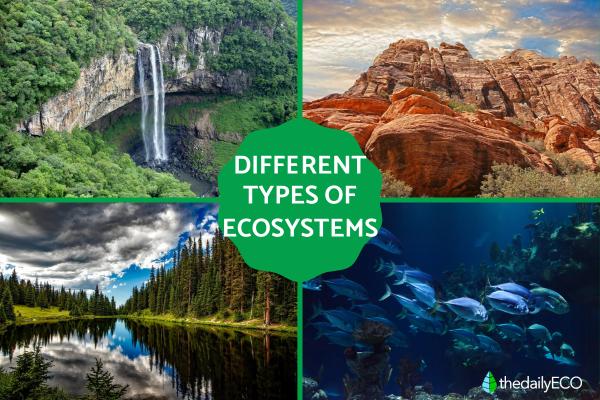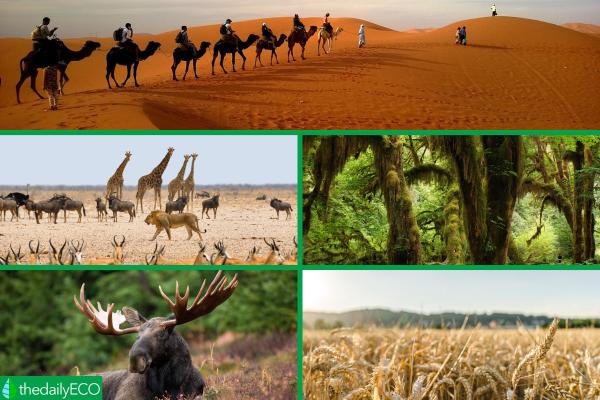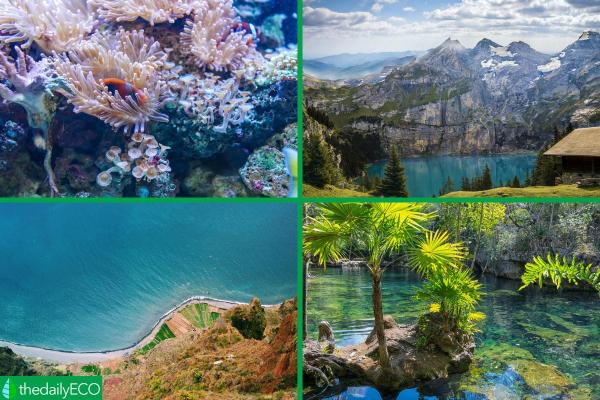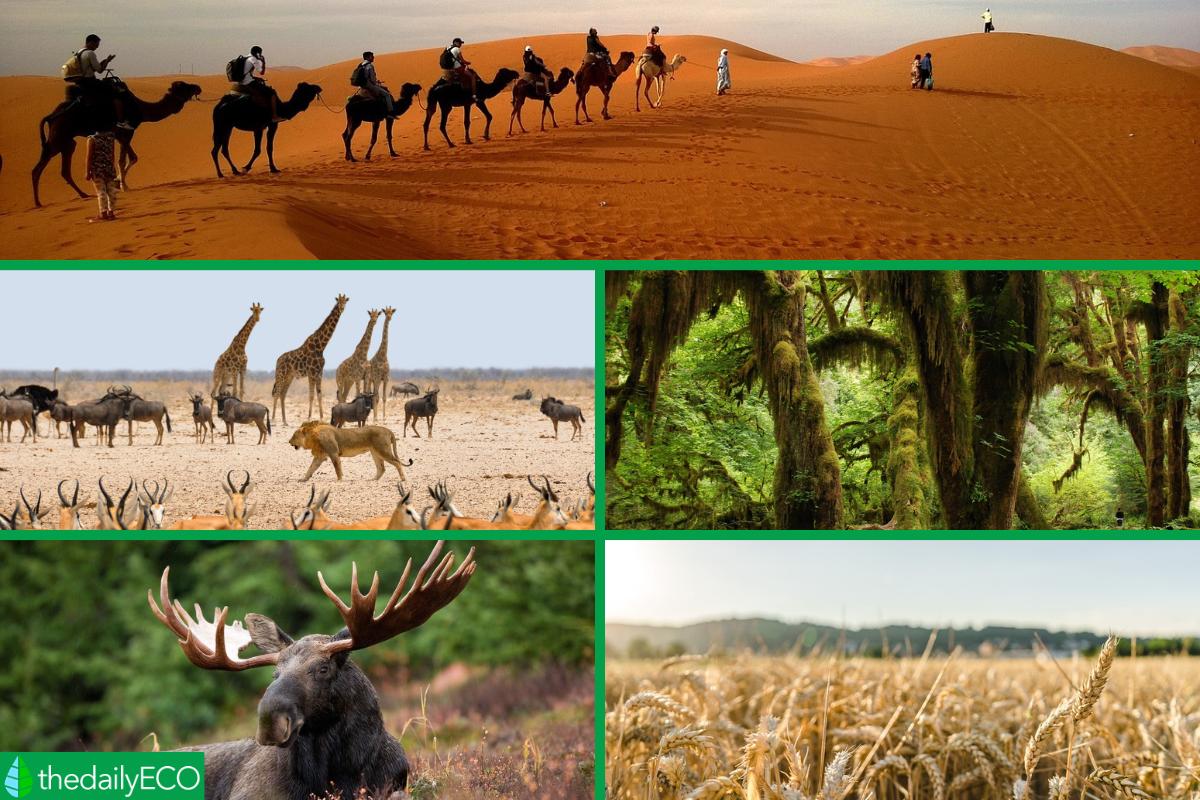Different Types of Ecosystems - List With Examples


We may be aware of the basic concept of an ecosystem, but it is easy to become overwhelmed once we start to look a little closer. The diversity and complexity of the world's ecosystems are only limited by space since every square millimeter of our planet is part of some larger ecosystem. Understanding how living organisms interact with each other is fundamental for ecologists. It allows us not only to understand how the natural world functions, but doing so helps us to find better ways to protect it.
Categorization in science is a very useful tool as it helps us to understand very complex ideas in more accessible ways. Understanding how living organisms interact with their physical environment is about as complex a challenge ecologists can face. For this reason, thedailyECO looks at different types of eco systems by providing a list of examples with photos.
What is an ecosystem?
The simplest definition of an ecosystem is that it is a highly complex biological system made up of living organisms interacting in a physical environment. Ecosystem is a portmanteau of ecological system and it is important to remember the connectivity of all organic life. These interactions form a network that supports biodiversity and ecological balance.
While ecosystems are as old as life itself, the concept was only coined in the 1930s by ecologists Arthur Tansley and Arthur Roy Clapham. The purpose of presenting the concept was to help us better understand how living organisms interact with each other and their environment. Ecosystems encompass a vast series of intra- and interspecies interactions, i.e. between their own species and others, respectively.
The resources available to these organisms also change greatly according to various factors. It is often said that ecosystems are in a certain balance. This is because various forms of matter and energy interconnect in ways which should be stable, but can become unstable due to many mitigating factors. In this sense, ecosystems are continuously evolving and adapting, even if some appear to remain the same for millennia. Consequently, understanding these dynamics is crucial for conservation efforts.
As ecosystems are always changing, they function by trying to maintain a certain equilibrium. A given ecosystem's ability to maintain said equilibrium is known as its resistance. The tendency to change due to disturbances in an ecosystem is known as its sensitivity, with some being more sensitive than others. These disturbances can be natural, but the world's ecosystems are increasingly having to adapt to human influence.
To help us understand how different ecosystems function and how some may be more resistant than others, it is helpful to look at the different types of ecosystems that exist on our planet. We look at the internal and external factors which exert pressure on these different ecosystems, as well as look at their main component parts. This will function as a basic guide to the different ecosystems and their fundamental characteristics.
Classification of different types of ecosystems
We know that ecosystems are complex entities, so ecologists have tried to classify them into different categories. This is not an easy task, but it is to the credit of numerous scientists that we have been able to create general classifications of different types of ecosystems. These categories are usually distinguished according to the environment in which they occur.
One of the most important factors we need to distinguish is between natural and artificial ecosystems, the latter being those which have been created or greatly influenced by humans. Differentiating between bodies of water and land is also important. For this reason, we can claim the world's ecosystems all fall into the following basic categories:
- Terrestrial ecosystems
- Aquatic ecosystems
- Mixed ecosystems (water-land) and air-terrestrial (air-land)
- Artificial or non-natural ecosystems of modified landscape (created by human beings)
In the following sections, we look at each of these types of ecosystem in more detail. By understanding these classifications, we can better appreciate how ecosystems function and their significance to the planet's health.

Terrestrial ecosystems
Terrestrial ecosystems occupy only 30% of the Earth's surface. Within this 30%, we can subdivide certain types of terrestrial ecosystems which have specific characteristics. They are:
- Deserts (30%)
- Savannahs and tropical grasslands, such as steppes, prairies and grasslands (20%)
- Jungles (23%)
- Forest ecosystem, i.e. temperate forests and tundras (17%)
- Crop areas (10%)
Each of these ecosystems supports different forms of life adapted to their unique environments. For example, deserts have organisms adapted to extreme heat and scarce water, while forests host diverse plant and animal life.
In the ecosystem images below, you can see the ones on this list in order. Understanding these ecosystems helps us to recognize the diversity of life and the importance of each type to the global environment.

Aquatic ecosystems
Aquatic ecosystems are characterized by the presence of water as the main physical component. This water can be freshwater or saltwater. In terms of the characteristics and habits of the organisms within these types of ecosystem, the salinity of the water is a very important factor. For example, certain plants will thrive when given freshwater or die when given saltwater. This is why it is so important to differentiate between marine and freshwater ecosystems. Marine and freshwater ecosystems are crucial for supporting aquatic biodiversity and global life.
Marine ecosystems
- Oceans
- Seas
- Reefs
- Shallow coastal waters
- Estuaries
- Coastal saltwater lagoons
Freshwater ecosystems
- Lakes
- Ponds
- Rivers
- Streams
- Springs
The level of salinity is not the only classification criteria of aquatic ecosystems. Another important factor we use to differentiate them is the movement of water within them:
- Lotic ecosystems: in which the movement of water occurs in a single direction, also known as river ecosystems. These ecosystems support a range of organisms that thrive in flowing waters.
- Lentic ecosystems: those with totally or partially stagnant waters, the most common type being lakes. Lentic ecosystems are home to many species of fish, plants, and microorganisms.
This categorization helps us to appreciate the complexity and importance of aquatic environments.
Mixed ecosystems
As we have mentioned before, ecosystems are located in certain terrains of the planet. It is very common for intersections between different types of terrain to occur within an ecosystem. This is what is referred to as a mixed ecosystem. While we may most associate this with liminal areas or areas where water and land meet, it also includes air-terrestrial ecosystems. Such ecosystems showcase the adaptability of life forms to varied environments.
Within these mixed ecosystems, we have flora and fauna which have adapted to their environment. For example, amphibians can live on both land and water. The main types of mixed ecosystems that exist in nature are:
- Wetlands
- Mangroves
- Marshes
- Coasts
Birds fly in the air and may catch prey mid-flight. Some will even remain in the air for days or weeks at a time, especially when migrating. Eventually they will need to land, meaning they are interacting with a mixed ecosystem.
These ecosystems are critical for maintaining biodiversity and serve as buffers against environmental changes.

Artificial ecosystems
With increasing frequency and speed, various artificial ecosystems are developing all around the world. Compared to the natural ecosystems that we have been seeing throughout this article, the characteristics of these ecosystems are determined by human beings. For this reason, we may refer to artificial ecosystems as anthropic or human ecosystems.
There are few ecosystems on this planet that have not had some interaction with humans. However, when we refer to human ecosystems, we mean those which are dominated by human beings. For example, although we can find humans in the deep Amazon rainforest, we do not consider it a human ecosystem. The main types of artificial ecosystems are:
- Urban ecosystems
- Agricultural or agricultural ecosystems
- Dam or reservoir ecosystems
Although human ecosystems are dominated by human beings, it does not mean they do not interact with natural organisms, energy and matter. We also find smaller ecosystems within a larger one. For example, we may find a botanical garden located within the limits of a city.
Also, we can view the entire planet as one single ecosystem. Changes and events which occur on one side of the world can have repercussions on its opposite. The future of human ecosystems requires protecting natural ecosystems and integrating the two in a more harmonious way. This requires great study and planning, but many efforts are already being made to build resistance and reduce sensitivity of various ecosystems.
As we advance technologically, understanding and managing artificial ecosystems becomes increasingly important for sustainable development.

If you want to read similar articles to Different Types of Ecosystems - List With Examples, we recommend you visit our Ecosystems category.
- Flowers, F.J., Agraz, C., & Benítez, D. (2007). Coastal aquatic ecosystems: importance, challenges and priorities for their conservation. National Institute of Ecology: Mexico, 147-155.
http://www2.inecc.gob.mx/publicaciones2/libros/533/ecosistemas2.pdf - Sánchez, O., et. al. (2007). Fundamental concepts on ecosystems. Perspectives on conservation of aquatic ecosystems in Mexico. National Institute of Ecology: Mexico. 37-46.
https://www.academia.edu/7833841/Libro_Ecosistemas_acuaticos_Oscar_Sanchez_et_al_2007 - Garcia, J.E. (2003). Investigating the ecosystem. Research in School Journal, 51, 83-100.
https://idus.us.es/handle/11441/60969








